
How to Optimize Your Laptop for Photo Editing
- Understand the recommended system requirements for photo editing software.
- Utilize software settings to improve performance.
- Keep your device updated for optimal results.
- Manage your storage and file organization effectively.
- Adjust your laptop’s display settings for accurate color representation.
Photo editing can be a demanding task for any laptop. However, with the right settings and software adjustments, you can significantly enhance your device's performance and streamline your workflow. This guide will walk you through various tips and tricks to optimize your laptop specifically for photo editing tasks.
Understanding system requirements
Before diving into optimization techniques, it's essential to understand the system requirements for photo editing software. While different programs may have varying needs, most will require certain baseline capabilities to run smoothly. Here are common requirements:
| Feature | Minimum Requirements | Recommended Requirements |
|---|---|---|
| Processor | Dual-core processor | Quad-core processor or higher |
| RAM | 8 GB | 16 GB or more |
| Storage | SSD with at least 256 GB | SSD with 512 GB or more |
| Graphics | Integrated graphics | Dedicated graphics card with OpenGL support |
| Display | 1366 x 768 resolution | 1920 x 1080 resolution or higher |
Optimizing software settings
To get the best performance from your laptop during photo editing, tweaking certain software settings is key. Here are some effective strategies:
- Close unnecessary programs: Ensure that only the necessary applications are open to free up your laptop’s resources.
- Adjust performance preferences: In your photo editing software, select performance settings that prioritize speed over graphical quality.
- Use proxy files: If dealing with large images, consider using lower resolution proxy files for editing, which can then be replaced with high-resolution files later.
Regular maintenance tips
Regular maintenance of your laptop is crucial in ensuring optimal performance. Follow these tips:
- Update software: Keep your photo editing software and operating system updated to the latest versions for improved performance and security.
- Clean up storage: Regularly delete unnecessary files and applications to prevent your disk from becoming cluttered.
- Run antivirus scans: Make sure your laptop is free from malware that could slow down performance.
Storage management
Efficient storage management is vital for successful photo editing. Consider implementing the following strategies:
- Use external drives: Store large photo files on external drives, freeing up your laptop’s internal storage for faster access and performance.
- Create an organized folder structure: Maintain an organized system for your files to quickly locate and access them during the editing process.
Display adjustments for accuracy
A laptop's display is critical for photo editing, as accurate color representation affects your work quality. Here's how to enhance your display settings:
- Calibrate your display: Regularly calibrate your laptop’s display to ensure that colors are displayed accurately.
- Adjust brightness and contrast: Fine-tune these settings to reduce eye strain and improve visibility while working for long hours.
Helpful software tools for optimization
In addition to the above methods, consider utilizing the following software tools to further enhance your laptop performance:
| Tool | Use |
|---|---|
| CCleaner | Cleans junk files and optimizes performance. |
| Malwarebytes | Scans and removes malware. |
| PhotoPills | Organizes and tracks photo editing projects. |
| Speccy | Provides detailed system information and diagnostics. |
| RescueTime | Monitors your productivity to better manage time spent on each task. |
Conclusion
Optimizing your laptop for photo editing not only improves its efficiency but also enhances your overall editing experience. By understanding system requirements, adjusting software settings, performing regular maintenance, and managing your storage effectively, you set yourself up for success in your photo editing projects.
For more information on making the most of your technology, check out our other articles in the Expert Tips category.
Pros
- Improved software performance.
- Enhanced photo accuracy.
- Better overall system health.
Cons
- Some optimizations may require technical knowledge.
- Initial time investment for setup.